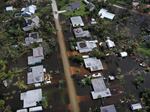
Hurricane Ian caused $112.9 billion dollars and more than 150 deaths when it slammed into south Florida in 2022, making it the costliest climate-fueled disaster in the U.S. last year.
Win McNamee / Getty Images
A town-flattening hurricane in Florida. Catastrophic flooding in eastern Kentucky. Crippling heatwaves in the Northeast and West. A historic megadrought. The United States endured 18 separate disasters in 2022 whose damages exceeded $1 billion, with the total coming to $165 billion, according to a new report from the National Oceanic and Atmospheric Administration (NOAA).
The annual report from the nation's premier meteorological institution highlights a troubling trend: Extreme weather events, fueled by human-caused climate change, are occurring at a higher frequency with an increased cost — in dollars and lives.
"Climate change is creating more and more intense, extreme events that cause significant damage and often sets off cascading hazards like intense drought, followed by devastating wildfires, followed by dangerous flooding and mudslides," said Dr. Rick Spinrad, NOAA's administrator, citing the flooding and landslides currently happening in California.
In five of the last six years, costs from climate and weather-related disasters have exceeded $100 billion annually. The average number of billion-dollar disasters has surged over that time, too, driven by a combination of increased exposure of people living in and moving to hazardous areas, vulnerability due to increasing hazards like wind speed and fire intensity, and a warming climate, the NOAA report said.
(2 of 6) The U.S. experienced 18 #BillionDollarDisasters in 2022 totaling more than $165 billion in damage.
— NOAA (@NOAA) January 10, 2023
122 separate billion-dollar disasters killed at least 5,000 people from 2016–2022.https://t.co/lwb0yKihEk@NOAANCEI @ametsoc #StateOfClimate #AMS2023 pic.twitter.com/FzzsNXSxRA
Climate-fueled hurricanes, in particular, are driving up damages. Hurricane Ian, which killed at least 150 people and pancaked entire neighborhoods when it made landfall in Florida as a Category 4 hurricane, cost $112.9 billion alone.
"There are, unfortunately, several trends that are not going in the right direction for us," said Adam Smith, an applied climatologist at NOAA. "For example, the United States has been impacted by a landfalling Category 4 or 5 hurricane in five out of the last six years."
Other worrying trends are clear too
The rise in frequency and intensity of extreme weather events mirrors a rise in global temperatures. The last eight years have been the warmest in modern history, European researchers said on Tuesday. Average global temperatures have increased 1.2 degrees Celsius (2.1 degrees Fahrenheit) since the Industrial Revolution, when humans started the widespread burning of fossil fuels to power economies and development.
Despite international pledges to cut climate-warming emissions and to move the world's economy to cleaner energy sources, global greenhouse gas emissions continue to rise. A report by the nonpartisan research firm Rhodium Group found that greenhouse gas emissions in the U.S. rose 1.3% in 2022. It was the second consecutive year emissions in the U.S. rose, after a pandemic-driven dip in 2020, despite the Biden administration's goal of cutting U.S. emissions in half by the year 2030.
The passage of the Inflation Reduction Act, the largest climate bill in U.S. history, was a "turning point," the Rhodium Group report said. "However, even with the IRA, more aggressive policies are needed to fully close the gap [to halve emissions] by 2030."
More extreme weather is expected in 2023
The frequency of billion-dollar disasters has increased greatly in recent years and the trend is expected to continue.
An analysis from the nonprofit Climate Central earlier this year found that between 2017 and 2021 the U.S. experienced a billion-dollar disaster every 18 days, on average. The average time between those events in the 1980s was 82 days.
The less time between events, the fewer resources there are to respond to communities affected, the Climate Central report noted.
To reduce the threat of deadly and costly weather events, scientists say the world needs to limit warming by urgently cutting climate-warming emissions. But as evidenced by recent events, the impacts of climate change are already here and adaptation efforts are needed as well.
"This sobering data paints a dire picture of how woefully unprepared the United States is to cope with the mounting climate crisis and its intersection with other socioeconomic challenges in people's daily lives," said Rachel Cleetus, a policy director at the Union of Concerned Scientists said in a statement. "Rather than responding in a one-off manner to disasters within the U.S., Congress should implement a comprehensive national climate resilience strategy commensurate with the harm and risks we're already facing."
Copyright 2023 NPR. To see more, visit https://www.npr.org.